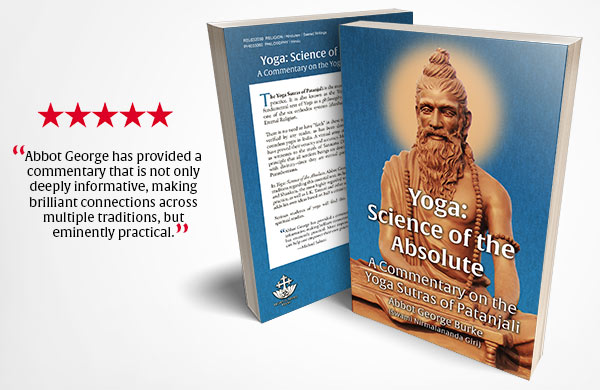
We have finished publication of Abbot George’s new book, Yoga: Science of the Absolute–A Commentary on the Yoga Sutras of Patanjali, and it is now available in paperback and ebook format at Amazon and other online outlets. For a limited time the ebook is on sale for only 99¢.
What are the Yoga Sutras?
The Yoga Sutras of Patanjali is the most authoritative text on Yoga as a practice. It is also known as the Yoga Darshana because it is the fundamental text of Yoga as a philosophy (though practice is discussed), one of the six orthodox systems (darshanas) of Sanatana Dharma, the Eternal Religion.
There is no need to have “faith” in these texts, for their statements can be verified by any reader, as has been done over thousands of years by countless yogis in India. A virtual army of self-realized men and women have proved their veracity and accuracy. Many of them are living right now as witnesses to the truth of Sanatana Dharma, which is based on the principle that all sentient beings are destined to attain liberation-union with divinity-since they are eternal parts of the Supreme Spirit, the Purushottama.
In “Yoga: Science of the Absolute“, Abbot George Burke draws on the age-long tradition regarding this essential text, including the commentaries of Vyasa and Shankara, the most highly regarded writers on Indian philosophy and practice, as well as I. K. Taimni and other authoritative commentators, and adds his own ideas based on half a century of study and practice.
Serious students of yoga will find this an essential addition to their spiritual studies.
A Sample from Yoga: Science of the Absolute
Sutra 3: 11. Samadhi transformation [parinama] is the [gradual] settling of the distractions and simultaneous rising of one-pointedness.
This change we desire comes about only gradually as the chitta itself begins to change.
This is important to know because in my yoga pilgrimage I came across some practices that instantly produced samadhi parinama. I was impressed, even at one point telling the one who had taught a certain method to me: “This is the hope of the world.” I was wrong! The practice carried with it extremely detrimental side-effects, both physical and psychological. I saw my fellow-practitioners disintegrating in body and mind while being “happy.” After a few months I realized that I must stop the practice or get into very deep trouble.
Later I met a psychotherapist who told me of patients who had gravely endangered their mental health through that method. He had himself learned it and after only a few sessions with it realized that it had great potential for harm. Other therapists who had investigated it came to the same conclusion.
A psychologist once told me that any drastic and almost instant change in body or mind is always pathological. Time has revealed to me that he was right. So even though yogis can become impatient and wonder: “When will it happen?” the inner world is not one of instant gratification but of steady and permanent change. So for the yogi it is true: Plod Rhymes With God. A teacher of Buddhist meditation, the Venerable Sumana Samanera, said:
“First of all, three things are required here: 1. persistence, 2. persistence, 3. persistence. Without great devotion, without extraordinary patience even one who is otherwise gifted will not be able to make progress.”
Yoga: Science of the Absolute–A Commentary on the Yoga Sutras of Patanjali is now available in paperback and ebook format at Amazon and other online outlets. For a limited time the ebook is on sale for only 99¢.








